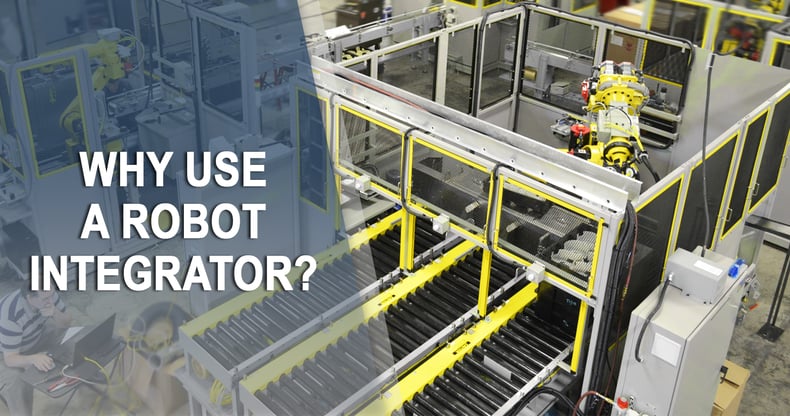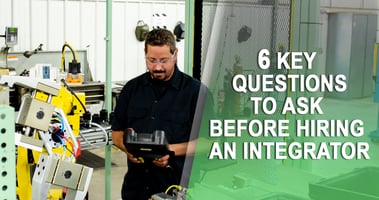Throughout the process of researching robotics integration for your manufacturing organization,...
4 Highly Worthwhile Reasons to Use an Integrator for Your Robotics System

Whether your goal is to reduce manpower, decrease waste, increase productivity, or achieve a higher level of precision and quality within your manufacturing operation, effectively leveraging a robotics system is a smart way to position your company for success. Nonetheless, there’s no denying that designing and building this type of system is a complex process, regardless of the industrial robot’s actual size or specifications.
Truthfully, carrying out a safe and lucrative robotics integration plan often requires a great deal more than the efforts of an in-house engineer.
Plus, there’s a number of factors to consider. You’re weighing the upfront investment versus total cost of ownership. You’re facing production downtime challenges. You’re thinking about the overall safety of your team.
And to manage these critical concerns as well as devise an approach that offers the best possible outcomes for your manufacturing facility, it’s important to understand the value of partnering with an expert robotics system integrator.
The robot itself is just one component of an entire multifaceted and interconnected business system. That means accounting for logistics like:
- Integrating the robot into your larger system
- Determining how much interaction the robot will have with humans
- Identifying appropriate time intervals
- Enabling the product’s control systems to communicate with your IT networks and other machines
- Meeting required safety parameters
Given the depth, breadth and integral nature of these issues, it’s no wonder many manufacturing companies rely on the knowledge, skills and experience of a robotics system integrator to ensure the most successful results. If you’re mulling over this decision for your own industrial robotics project, here are some essential insights you’ll want to take into consideration.
1. There’s no substitute for experience.
A professional robotics integrator designs, builds, and programs the entire system that propels an industrial robot. With expertise in a variety of areas, integrators are able to offer a solution to their customers for many applications. These applications often include assembling, inspecting, machine tending, removing material, managing custom applications, and administering repairs.
You may be highly in tune with what goes on inside your facility and what you desire to achieve from a business perspective, but robotics system integrators perform this specialized work day in and day out, with so many different businesses and manufacturing processes. Robotics integration partners have the advantage of this comprehensive knowledge and skill development from which to base their approach so that your implementation is laser-focused.
Without this level of experience and skill refinement, you risk making an investment in a robotics project that may not meet your business case expectations. And that’s not generally the end game that a manufacturing facility can afford to bear.
2. Downtime is inevitable, but wasted time is not.
Regardless of what solutions you adopt for your robotics system integration, you’re going to face instances of downtime. That’s an inescapable reality at any manufacturing company. But exactly how much downtime you allow to unfold is absolutely within your control.
While robotics integrators understand that there will be stoppages of automation, they have the proficiency and know-how to recover in mere seconds. If your in-house team does not have the necessary comprehension of fault diagnostics and recovery logic, they’re not positioned to limit downtime nearly as effectively.
Consider, for example, that your robot crashes into something or a worker unexpectedly hits an emergency stop. It’s likely to take an operator without specialized robotics integration experience several minutes to get the machine back to its start position and resume operation. Wauseon Machine’s integrators, on the other hand, can get the robot home in a matter of seconds with the push of a button.
3. Safety is so much more than a good intention.
When it comes to ensuring safety along the course of integrating and applying a robotics system, there’s a great deal of risk involved if you don’t have a comprehensive grasp of the requirements set forth by the Robotic Industries Association (RIA) and International Organization for Standardization (ISO). A lack of experience and training in this area could endanger your workers and incur injury liability for your company.
The RIA mandates a risk assessment for every installation of a robotic system. To perform a compliant and effective risk assessment—one that supports the design of a safe machine—you need to have the kind of specific safety standards knowledge that your everyday engineer is unlikely to possess. It’s an extremely methodical process. In fact, the RIA updates their safety standards periodically, and each update requires new training.
When you work with a robotics integrator, this training and experience is built into the partnership, which enables you to minimize the risk of noncompliance, workplace injury, and company liability.
4. The “cheaper” way is not always the least expensive.
Some manufacturing companies see the cost of robotics integration as an upfront investment only. And when you’re weighing the expense through that lens, it’s certainly true that executing an in-house project may be cheaper than working with a professional integrator. After all, you’re buying the same products, which cuts out the cost of an integrator’s profit margins.
But looking at a robotics integration in such a shortsighted way is very likely to result in a more expensive total cost of ownership two or three years down the road. With the reliability of an integrator solution that provides greater Overall Equipment Effectiveness (OEE), your system is going to necessitate less maintenance and downtime.
If you achieve a truly successful integration guided by the expertise of a professional integrator, you’re poised to maximize productivity and minimize waste. Faster production capabilities and decreased maintenance costs will absolutely impact your overall cost savings over the long term. So even though an initial upfront investment with an integrator may be pricier, your total cost of ownership is apt to be significantly less in the long run.
If you’re interested in learning more about how to embrace the kind of approach to your robotics systems integration that reaps major value for your manufacturing company, check out our free tip sheet now.



